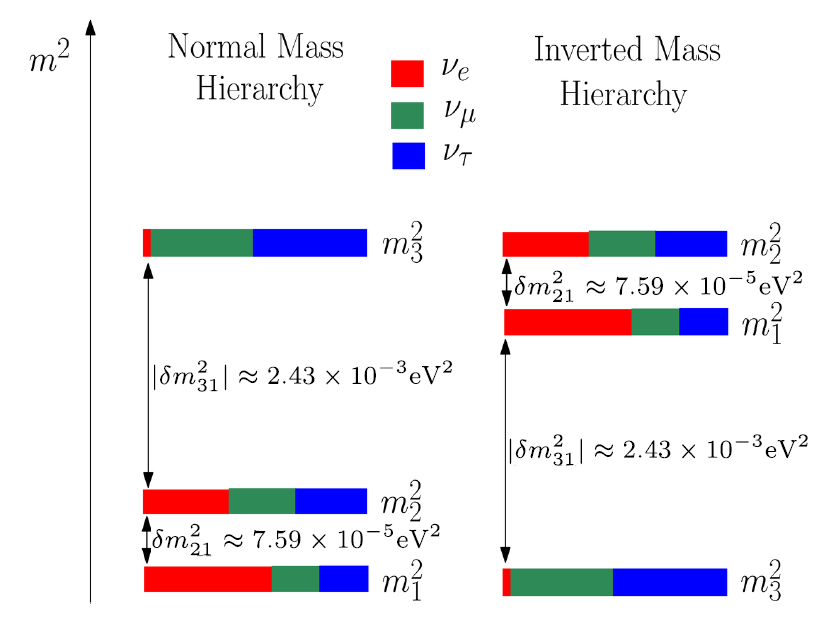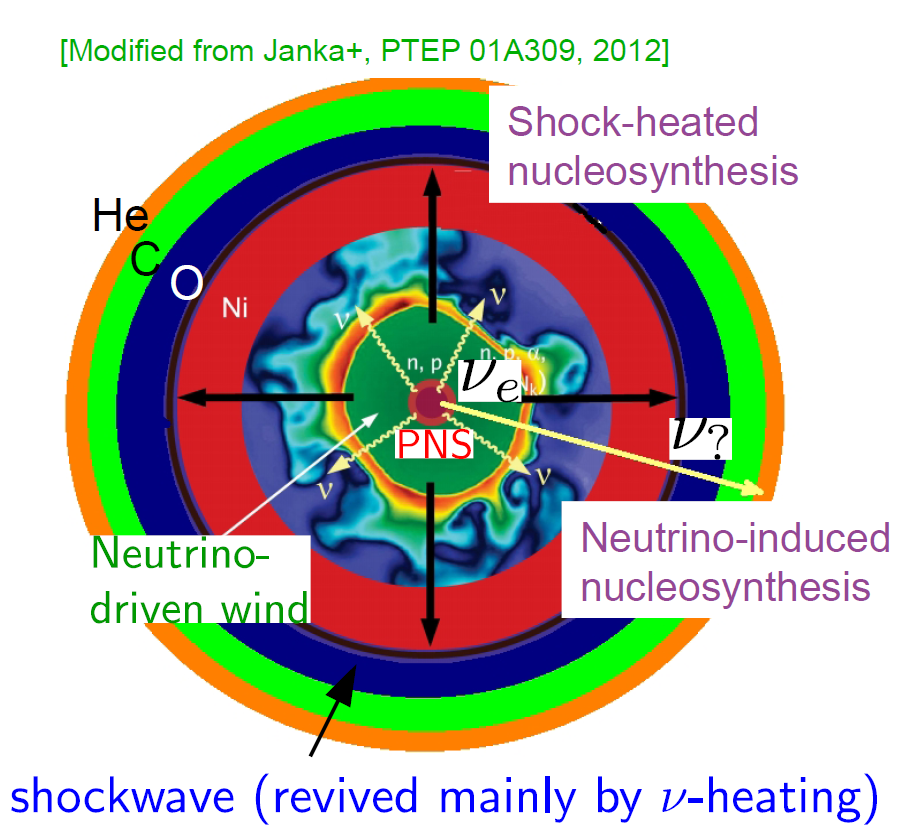Übersicht
Neutrino oscillations in dense neutrino gas
 Neutrino flavor oscillations observed by various experiments have led to
the discovery that neutrinos are massive and their vacuum
mass eigenstates are distinct from the flavor states
[1] .
At present, nearly all the mixing parameters have
been measured [2]. However, there remain many unknowns of neutrinos
such as the mass hierarchy, the CP-violating phase(s),
the absolute masses, its Dirac or Majorana nature,
and the possibility of sterile neutrinos (Standard Model singlet)
that may not be easily accessed in terrestrial experiments.
Neutrino flavor oscillations observed by various experiments have led to
the discovery that neutrinos are massive and their vacuum
mass eigenstates are distinct from the flavor states
[1] .
At present, nearly all the mixing parameters have
been measured [2]. However, there remain many unknowns of neutrinos
such as the mass hierarchy, the CP-violating phase(s),
the absolute masses, its Dirac or Majorana nature,
and the possibility of sterile neutrinos (Standard Model singlet)
that may not be easily accessed in terrestrial experiments.
Neutrinos play important roles in the early Universe, core-collapse supernovae, and in neutron star-neutron star or neutron star-black hole mergers. Enormous amount of neutrinos are present in these environments influencing the physical processes. Moreover, we may use these "cosmological and astrophysical laboratories" to help constrain the fundamental properties of neutrinos. In order to fully understand the role of neutrinos in these environments, it is essential to know how neutrinos change their flavor when large neutrino fluxes gives rise to the non-linear couplings between neutrinos with different momenta [3]. This is a challenging task as it is an intrinsic many-particle, multi-dimensional, non-equilibrium quantum problem. Intensive studies of different groups all over the world has been done in the past decades (e.g. see [3] [4] and the refereces therein).

In our group, we have been working together with our collaborators to improve the modelling and understanding of neutrino oscillations in supernovae and in mergers for the following aspects:
Neutrino oscillations in dense neutrino gas
 Neutrino flavor oscillations observed by various experiments have led to
the discovery that neutrinos are massive and their vacuum
mass eigenstates are distinct from the flavor states
[1] .
At present, nearly all the mixing parameters have
been measured [2]. However, there remain many unknowns of neutrinos
such as the mass hierarchy, the CP-violating phase(s),
the absolute masses, its Dirac or Majorana nature,
and the possibility of sterile neutrinos (Standard Model singlet)
that may not be easily accessed in terrestrial experiments.
Neutrino flavor oscillations observed by various experiments have led to
the discovery that neutrinos are massive and their vacuum
mass eigenstates are distinct from the flavor states
[1] .
At present, nearly all the mixing parameters have
been measured [2]. However, there remain many unknowns of neutrinos
such as the mass hierarchy, the CP-violating phase(s),
the absolute masses, its Dirac or Majorana nature,
and the possibility of sterile neutrinos (Standard Model singlet)
that may not be easily accessed in terrestrial experiments.
Neutrinos play important roles in the early Universe, core-collapse supernovae, and in neutron star-neutron star or neutron star-black hole mergers. Enormous amount of neutrinos are present in these environments influencing the physical processes. Moreover, we may use these "cosmological and astrophysical laboratories" to help constrain the fundamental properties of neutrinos. In order to fully understand the role of neutrinos in these environments, it is essential to know how neutrinos change their flavor when large neutrino fluxes gives rise to the non-linear couplings between neutrinos with different momenta [3]. This is a challenging task as it is an intrinsic many-particle, multi-dimensional, non-equilibrium quantum problem. Intensive studies of different groups all over the world has been done in the past decades (e.g. see [3] [4] and the refereces therein).

In our group, we have been working together with our collaborators to improve the modelling and understanding of neutrino oscillations in supernovae and in mergers for the following aspects:
- More consistent inputs from astrophysical simulations:
The collective neutrino flavor oscillations can very sensitively depend on (i) the competition between the neutrino-neutrino forward scattering potential and the neutrino-electron potential, and (ii) the neutrino phase-space distribution functions of all flavors. In a realistic astrophysical environment, all those quantities evolve with time. Thus, it is important to perform calculations with consistent inputs from astrophysical simulations such as done in [5].
- Coupling flavor oscillations with composition and hydrodynamical
evolution:
If neutrino flavor oscillations happen close enough to their emission surface, the change of the energy spectra of electron neutrinos and antineutrinos can cause the change of the composition and the hydrodynamical qunatities of the surrounding. Interesting feedbacks/interplays may appear such as shown in [6].
- Physical mechanism governing the flavor oscillations:
Aside from the numerical calculations of neutrino oscillations, we are also investigating the underlying mechanism that governing the complicated flavor evolution in these environments. For example, see [7] for our most recent effort to account for the "matter neutrino resonances".
References
- [1] 2015 Nobel Prize of physics
- [2] Wiki page of neutrino oscillations
- [3] H. Duan, G. M. Fuller and Y.-Z. Qian, Ann.Rev.Nucl.Part.Sci. 60, 569 (2010), arXiv:1001.2799
- [4] H. Duan, Int. J. Mod. Phys. E24, 1541008 (2015), arXiv:1506.08629
- [5] M.-R. Wu, Y.-Z. Qian, G. Martinez-Pinedo, T. Fischer, L. Huther, Phys. Rev. D91, 065016 (2015), arXiv:1412.8587
- [6] M.-R. Wu, T. Fischer, L. Huther, G. Martinez-Pinedo and Y.-Z. Qian, Phys. Rev. D89, 061303 (2014), arXiv:1305.2382
- [7] M.-R. Wu, H. Duan, and Y.-Z. Qian, arXiv:1509.08975


